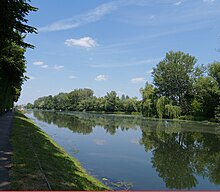Wilanów
|
Wilanów district of Warsaw |
|
|---|---|
| Coordinates | 52 ° 10 ′ 0 ″ N , 21 ° 5 ′ 0 ″ E |
| surface | 36.73 km² |
| Residents | 14,032 (2003) |
| Population density | 382 inhabitants / km² |
| Website | www.wilanow.pl |
| License Plate | WW |
| politics | |
| mayor | Rafał Miastowski |
Wilanów (from Italian: Villanova ) is a municipality of Warsaw . It is located on the western bank of the Vistula and on the southern edge of the city. From 1994 to 2002 Wilanów was a municipality with the status of an independent municipality.
With a population of 14,000, Wilanów is the smallest in terms of population and the most sparsely populated district of the Polish capital with 355 inhabitants / km².
Wilanów Palace

Wilanów is best known for its palace, Palais Wilanów , which was built from 1677 to 1679 by Augustyn Wincenty Locci on behalf of King Jan III. Sobieski and is known as the Polish Versailles . The baroque furnishings glorified the victories of Jan III. Sobieskis and the virtues of his wife Queen Marysieńka . After the death of Jan III. Sobieski, his successor, King Augustus the Strong , resided here until 1700. He was famous for the large and extravagant parties that he held in the castle. Thereafter, the palace was successively owned by the Sieniawski , Lubomirski , Czartoryski , Potocki and Branicki families , who redesigned the palace in the style of the following eras. The palace was looted and burned down by the German Wehrmacht in 1944 after the Warsaw Uprising . However, due to the advance of the Red Army, they were no longer able to achieve their original goal of completely destroying this symbol of the Polish nation . The palace was rebuilt in its original baroque form after the Second World War .
The interior decoration includes the styles of baroque , rococo and classicism . You can visit the library, the Potocki Museum with numerous sculptures and the living rooms with numerous paintings, including the famous portrait of Jan Sobieski as a warrior on horseback. The collection of Baroque grave portraits is the largest in the world. The facade facing the park has a sundial designed by the Gdańsk astronomer Hevelius , which shows the time and the zodiac sign .
Castle Park
Wilanów Park was laid out in the 17th century in the Baroque style based on the Italian-French model on an area of 43 hectares. Later parts were redesigned in the romantic style . Numerous park structures and sculptures decorate the park. The oldest part of the garden was reconstructed by Gerard Ciołek on the terraces in front of the castle in geometric shapes with fountains and figures. In the English Park north of the castle there are several sarcophagi of the castle owners, obelisks and columns. The rose garden to the west of the palace is in the neo-renaissance style.
Potocki crypt

In particular, the neo-Gothic tomb above the Potocki crypt deserves attention. The mausoleum was built from 1799 to 1892, the tomb was completed in 1832 based on a project by Henryk Marconi with sculptures by Jakub Tatarkiewicz and Konstanty Hegel .
Orangery and Chinese Pavilion
The palace garden has an orangery and a Chinese pavilion in the English Park. The important poster museum is located near the orangery.
Poster museum
The poster museum in Wilanów is dedicated to the art of posters. It collects posters from Poland and around the world. It is located in the converted building of the former riding school on the site of the Wilanów Royal Castle.
St. Anne's Church
St. Anne's Church in the park was built for Adam Kazimierz Czartoryski in the classicist style between 1772 and 1775 and rebuilt in the neo-Renaissance style by Henryk Marconi and Jan Kacper Heurich from 1857 to 1870 .
Miasteczko Wilanów
Miasteczko Wilanów is a new district of Wilanów that was built in 2002.



